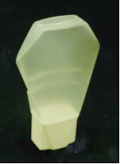
Shape of a white transparent bottle possesses required distinctiveness to be registered as a three-dimensional mark
"42. All in all, it must be noted that a minimum degree of distinctiveness is sufficient to render inapplicable the ground for refusal set out in Article 7(1)(b) of Regulation No 40/94 (see Case T-34/00 Eurocool Logistik v OHIM (EUROCOOL) [2002] ECR II-683, paragraph 39; and, to that effect, Grille, paragraph 49). Accordingly, since, as stated above, the mark applied for is made up of a combination of elements, in a characteristic presentation, which distinguish it from other shapes available on the market for the products concerned, it must be held that the mark applied for, taken as a whole, possesses the minimum degree of distinctiveness required."
Registrations already made in Member States are a factor which may be taken into account for the purposes of registering a community trade mark
"47. As the Court stated at paragraph 40 above, the three-dimensional mark applied for is unusual and capable of enabling the products in question to be distinguished from those having a different commercial origin. That position is supported by the registration by the applicant of a three-dimensional mark having an identical shape to that of the mark applied for in the present case, in 11 Member States.
48. It follows from all the above considerations, and without there being any need to reach a decision on the other arguments put forward by the applicant, that the Board of Appeal was wrong to hold that the mark applied for was devoid of any distinctive character for the purposes of Article 7(1)(b) of Regulation No 40/94."
IPPT20041124, ECJ, Henkel v OHIM
T-393/02 - ECLI:EU:T:2004:342

















